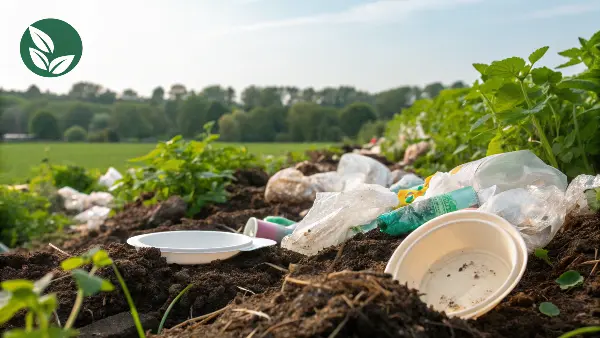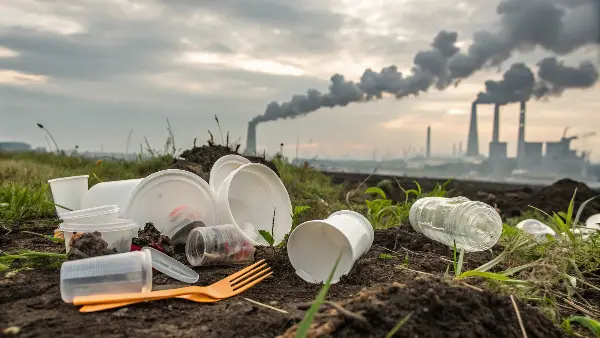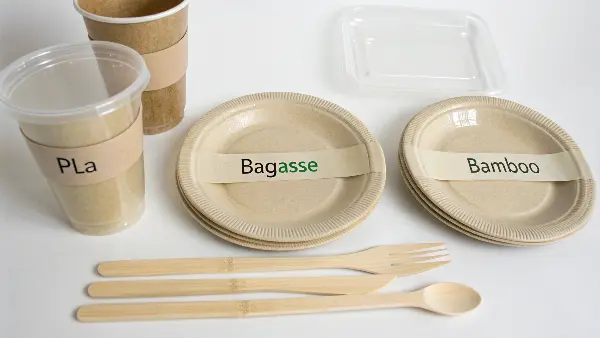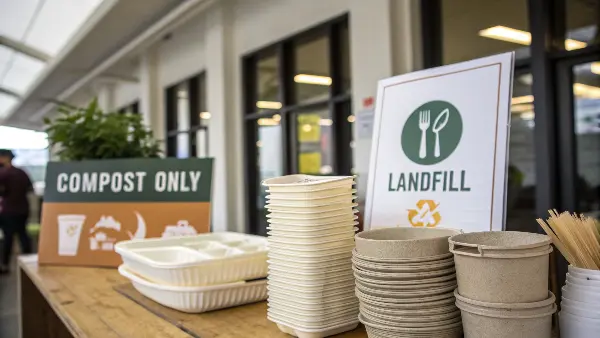Feeling overwhelmed by news of overflowing landfills and polluted skies? You see plastic waste everywhere and wonder if your business choices can truly make a difference. What if switching your tableware could be a simple yet powerful step toward cleaner air and healthier soil? It’s a change that benefits both your brand and the planet.
Biodegradable tableware directly reduces air and soil pollution by diverting waste from landfills, where plastics leach toxins into the soil. Unlike plastics that release harmful chemicals when incinerated, biodegradable products break down into natural elements. When properly composted, materials like bagasse and PLA enrich the soil, turning waste into a valuable resource instead of a permanent pollutant.

It’s easy to see the appeal of these eco-friendly options, but the science behind their impact is what truly matters. We need to look closely at how these materials are made, how they break down, and how they compare to the traditional plastics they are designed to replace. Understanding this lifecycle is key to making informed, sustainable choices. So, let’s explore the specific ways this simple switch contributes to a healthier planet.
What makes traditional plastic tableware so harmful to our air and soil?
We see plastic cups, forks, and containers everywhere; they’re cheap and convenient. But this convenience comes at a steep price for our environment, creating problems that last for centuries. The real damage to our air and soil is often hidden, happening slowly but with devastating effects. Understanding this damage is the first step toward finding a real solution.
Traditional plastic tableware harms air and soil throughout its entire life. Its production releases greenhouse gases and other pollutants. During disposal, it leaches toxic chemicals into soil and groundwater for hundreds of years. If incinerated, it releases harmful substances like dioxins and furans into the atmosphere, directly contributing to air pollution and acid rain.

The problem with plastic is that it never truly goes away. It just breaks down into smaller and smaller pieces called microplastics. These tiny fragments are now found in everything from our farmland to our water sources. They disrupt ecosystems and can absorb other toxins, making the soil less fertile and more hazardous. When I work with clients like Jacky in Canada, their main concern is finding a way to escape this damaging cycle. The evidence is clear: our reliance on single-use plastics has created a legacy of pollution that affects both our air quality and the very ground beneath our feet.
The Lifecycle of Plastic Pollution
The damage from plastic isn’t just a disposal issue; it begins the moment it’s created. The entire lifecycle is a source of pollution.
- Fossil Fuel Extraction and Production: Most plastics are derived from petroleum. The process of extracting and refining oil releases significant amounts of carbon dioxide (CO2), methane, and other greenhouse gases into the atmosphere. The manufacturing plants that turn these raw materials into plastic products are also major sources of industrial air pollution.
- Persistent Soil Contamination: When plastic cutlery or containers end up in a landfill or are simply littered, they begin a slow degradation process that can take over 500 years. During this time, chemical additives used in the plastic (like phthalates and BPA) can leach out, contaminating the soil and nearby water sources.
The Microplastic Menace
The most insidious problem is the creation of microplastics. As larger plastic items are exposed to sunlight and physical stress, they fracture into tiny particles.
| Pollution Source | Impact on Air | Impact on Soil |
|---|---|---|
| Plastic Production | Releases CO2, methane, and volatile organic compounds (VOCs). | Can cause localized soil pollution near manufacturing facilities. |
| Landfill Disposal | Methane gas is released as other organic waste decomposes around it. | Leaches toxic additives (BPA, phthalates) into the soil and groundwater. |
| Incineration | Releases dioxins, furans, mercury, and other toxic gases. | Ash residue can contain heavy metals and other toxins, contaminating land. |
| Littering | Minimal direct air impact, aside from potential burning. | Breaks down into microplastics, harming soil structure and fertility. |
How does the disposal of biodegradable products protect the soil?
Businesses often focus on what happens before a product reaches the customer. But what happens after is just as important. Traditional packaging clogs landfills for centuries, but what if disposal could actually benefit the earth? This shift in thinking is at the core of why biodegradable products are so revolutionary for soil health.
Proper disposal of biodegradable tableware protects the soil by turning waste into a resource. When sent to an industrial composting facility, these items break down into humus, a nutrient-rich organic material. This compost improves soil structure, helps it retain water, and reduces the need for chemical fertilizers. It actively enriches the earth instead of polluting it.

The key here is "proper disposal." While some materials can break down in a home compost bin, many products, especially those made from PLA, require the specific high-heat conditions of an industrial composting facility to fully biodegrade. I once worked on a project for a large outdoor festival in Europe. They switched to our PLA cups and bagasse food containers. By partnering with a local composting service, they diverted tons of waste from the landfill. Instead of leaving behind a mountain of plastic trash, they created nutrient-rich compost that was later used in city parks. This is a perfect example of a circular economy in action, where a product returns to the earth without causing harm.
Turning Waste into a Valuable Resource
The process of composting is nature’s way of recycling. Biodegradable materials, derived from plants, are full of organic matter that microorganisms love to eat.
- The Composting Process: In a controlled environment with the right balance of heat, moisture, and oxygen, microorganisms break down materials like bagasse, bamboo, and PLA into their basic components. The final product is dark, crumbly, and looks like healthy soil. This is humus, or compost.
- Benefits of Compost: This finished compost is a powerful soil amendment. It improves aeration, increases water retention (reducing runoff), and provides essential nutrients for plant growth. Using compost reduces and can even eliminate the need for synthetic chemical fertilizers, which themselves can be a source of water and soil pollution.
Avoiding Landfill Methane
When biodegradable items mistakenly end up in a landfill, the situation is more complicated. Landfills are anaerobic environments, meaning they lack oxygen.
| Disposal Method | Impact on Soil | Key Requirement |
|---|---|---|
| Industrial Composting | Creates nutrient-rich compost, enriches soil, improves water retention. | Access to a commercial composting facility that accepts food service ware. |
| Landfill | Occupies space; can release methane if not properly managed. Avoids plastic leaching. | Standard waste collection. Not the ideal end-of-life scenario. |
| Incineration | Burned for energy. Cleaner than plastic, but nutrients are lost. | Waste-to-energy facility. Carbon is released as CO2. |
| Home Composting | Suitable for some materials (like uncoated paper), but not for PLA. | Right balance of "greens" and "browns," proper aeration. |
By choosing composting, we aren’t just avoiding the harm of plastic; we are actively participating in a cycle that regenerates and heals our soil.
What are the key materials in biodegradable tableware and how do they help?
You might hear terms like PLA, bagasse, and bamboo used interchangeably, but each material has a unique origin and specific benefits. Knowing the difference helps you make the best choice for your needs. The story behind these materials is what makes them so powerful. They come from nature, and they are designed to return to it.
The key materials are PLA (Polylactic Acid), made from cornstarch; bagasse, a byproduct of sugarcane processing; and bamboo, a fast-growing grass. These materials help by using renewable resources instead of fossil fuels. Their production generally has a lower carbon footprint, and they are designed to be compostable, avoiding the permanent pollution caused by plastic.

Each material serves a different purpose, which is something I often discuss with clients. For a coffee shop needing clear cups for cold brews, PLA is a perfect plastic alternative. For a restaurant serving hot, heavy meals, the strength and grease-resistance of a bagasse container is ideal. And for sturdy, reusable-feeling cutlery, bamboo is a fantastic choice. The beauty is in the diversity of solutions. We are no longer limited to a single, polluting material. We can choose the right tool for the job, and each one comes from a sustainable, renewable source that actively helps reduce our environmental footprint from the very start.
A Closer Look at the Materials
Understanding the source of these materials is crucial to appreciating their environmental benefits. They represent a shift from a finite, polluting resource (oil) to a renewable, circular one (plants).
- PLA (Polylactic Acid): This is a bioplastic made from fermenting plant starches, usually from corn or sugarcane. It looks and feels like traditional clear plastic (PET) but is commercially compostable. It’s great for cold applications like cups, lids, and containers. Its production uses significantly less energy than petroleum-based plastics.
- Bagasse: This is the dry, fibrous pulp that remains after sugarcane stalks are crushed to extract their juice. Instead of being discarded or burned (which would cause air pollution), this waste material is molded into strong, durable products like plates, bowls, and takeout containers. It’s microwave-safe and handles hot and oily foods well.
- Bamboo: As one of the fastest-growing plants on Earth, bamboo is an incredibly renewable resource. It requires no pesticides or fertilizers to grow and regenerates from its own roots. Bamboo tableware is known for its strength and natural, attractive appearance.
The Environmental Advantage of a Plant-Based Origin
The simple fact that these materials come from plants gives them a massive head start over plastic.
| Material | Primary Source | Best For | Key Environmental Benefit |
|---|---|---|---|
| PLA | Cornstarch or Sugarcane | Cold cups, clear containers, cutlery | Lowers greenhouse gas emissions during production compared to PET plastic. |
| Bagasse | Sugarcane Fibers (a byproduct) | Plates, bowls, hot food containers | Upcycles an agricultural waste product, preventing it from being burned. |
| Bamboo | Bamboo Plant | Cutlery, sturdy plates, reusable-style items | Highly renewable resource that grows rapidly without chemical inputs. |
| Kraft Paper | Wood Pulp (FSC Certified) | Bags, coffee cups, food boxes | Sourced from sustainably managed forests, biodegradable and easily recyclable. |
By choosing products made from these renewable resources, we are supporting an agricultural system that absorbs CO2 from the atmosphere. This stands in stark contrast to the fossil fuel industry, which only adds carbon to it.
Are there any challenges or misconceptions about biodegradable tableware?
Switching to sustainable products is a huge step forward, but it’s not a magic bullet. To make a real impact, we have to be honest about the challenges. Misinformation can lead to greenwashing, and I believe in giving my partners the full picture so they can use these products effectively and responsibly.
Yes, a major challenge is ensuring proper disposal. Many biodegradable products, especially PLA, require industrial composting facilities to break down efficiently. If they end up in a landfill, they can produce methane. Another misconception is that "biodegradable" means it can be littered; these products must be disposed of in the correct waste stream to be beneficial.

This is why education is a huge part of what we do at Ecosourcecn. When I talk to a new client, one of my first questions is, "What are the waste management capabilities in your area?" If industrial composting isn’t available, we might focus on other solutions, like products made from FSC-certified paper that can be more easily recycled or composted at home. Being realistic about the end-of-life scenario is just as important as choosing a product with a green beginning. We have to close the loop responsibly to get the full environmental benefit and avoid creating new problems.
Navigating the End-of-Life Puzzle
The term "biodegradable" can sometimes be confusing. It’s essential to understand the different labels and what they mean for disposal.
- Biodegradable vs. Compostable: "Biodegradable" is a general term meaning a material can be broken down by microorganisms. "Compostable," however, is a more specific certification (like EN13432 or ASTM D6400) that guarantees a product will break down into non-toxic components within a certain timeframe under specific conditions (usually in an industrial facility). For a product to be truly eco-friendly, compostability is the gold standard.
- The Landfill Problem: In a landfill, the lack of oxygen means that even biodegradable products decompose very slowly through an anaerobic process. This process can release methane, a greenhouse gas that is far more potent than carbon dioxide. While it’s still better than plastic that leaches chemicals, it’s not the ideal outcome.
The Importance of Clear Communication
To overcome these challenges, clear communication with the end-user is vital.
| Challenge | Best Practice / Solution | Why It’s Important |
|---|---|---|
| Lack of Composting Infrastructure | Check local facilities first. If unavailable, prioritize recyclable (paper) or home-compostable products. | Ensures the product can complete its sustainable lifecycle as intended. |
| Consumer Confusion | Use clear on-package labeling (e.g., "Commercially Compostable Only"). Provide clear instructions at points of disposal. | Prevents contamination of recycling streams and ensures products go to the right place. |
| "Greenwashing" Claims | Look for third-party certifications (BPI, TUV Austria, FSC). Ask suppliers for compliance documentation. | Guarantees that the product meets legitimate environmental standards. |
| Cost Concerns | Factor in the long-term value of brand reputation and meeting customer demand for sustainability. | The market is shifting, and investing in sustainability is becoming a competitive advantage. |
Ultimately, overcoming these hurdles requires a partnership between suppliers, businesses, and consumers. By being transparent and proactive, we can ensure that these amazing products deliver on their promise to protect our air and soil.
Conclusion
Switching to biodegradable tableware is a definitive step toward reducing air and soil pollution. It shifts us away from the toxic lifecycle of plastics by using renewable resources, lowering carbon emissions during production, and enriching our soil through composting. This is a practical, powerful choice for a cleaner and healthier world.


